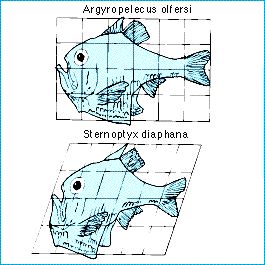D'Arcy Thompson's transformations

D'Arcy Thompson found that related species superficially looking very different could in some cases be represented as simple Cartesian transformations of one another. The most thoroughly worked out modern example of this is Raup's analysis of snail shell shapes with a morphospace.
With some simplification, the axes on the fish grids in here or the snails of the morphospace can be thought of as growth gradients. The evolutionary change between the species would then have been produced by a genetic change in the regulatory mechanisms controlling those gradients.
If we looked at these fish without the grids we might think that an evolutionary change from one into the other would be at least moderately complicated. The interest of D'Arcy Thompson's diagrams is then to show that shape changes could have been produced by heterochrony - a change in the rate or timing of development of some cell lines in the body relative to others.
An interactive animation allows you to explore some of D'Arcy Thompson's transformations.
Figure: a D'Arcy Thompson transformational diagram. The shapes of two species of fish have been plotted on Cartesian grids. Argyropelecus olfersi could have evolved from Sternoptyx diaphana by changes in growth patterns corresponding to the distortions of axes. From D'Arcy Thompson (1942).
| Next |



